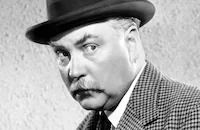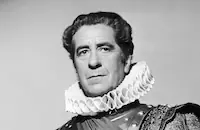Vendetta
Cast & Crew
Mel Ferrer
Faith Domergue
Hillary Brooke
Nigel Bruce
Joseph Calleia
Hugo Haas
Film Details
Technical Specs

Synopsis
In 1825, in French-controlled Corisca, elderly Antonio Della Rebbia is summoned by Alberto Barracini to a meeting in a desolate valley known as the "maquis" and is shot in the back by Alberto's brother Vincente. Following the custom of the island, Antonio is buried in the same spot where he was slain and is doomed to remain in unhallowed ground until his murder is avenged by his eldest son. Although the powerful Barracini family, who had been involved in land disputes with Antonio, are not immediately arrested for the crime, Antonio's daughter Colomba fights to have them brought to trial in their village, Pietranera. The Barracinis, however, produce a forged letter and a witness, Arrigo, who testifies that the "bandit" Padrino had asked him to deliver a letter to Antonio, inviting him to the maquis. The ruling French prefect declares the Barracinis innocent and insinuates that Padrino, a political fugitive, is guilty. Colomba's fury at the Barracinis' acquittal is tempered somewhat by the knowledge that her older brother Orso is soon returning home after ten years of military service in France. Colomba rides to the maquis, where Padrino, a family friend, and his servant, Brando, live in secret, and reassures him that Orso will do his duty. On his Corisca-bound ship, Orso, meanwhile, romances Lydia Nevil, an English aristocrat vacationing with her father, Col. Sir Thomas Nevil. Although he speaks fondly of his homeland, Orso denounces the Coriscan practice of vendettas and describes himself a man of peace and reason. Upon landing in the Coriscan capital of Ajaccio, Orso is met by Colomba, who immediately senses that he has changed. Colomba disapproves of the Nevils, whom she regards as frivolous, but encourages Col. Nevil to give Orso a double-barrel rifle from his gun collection. Orso then invites the Nevils to stay with him at Pietranera, angering Colomba. In Pietranera, Orso is given a hero's welcome by Vincente and Alberto's father Guido, the mayor. Despite the Barracinis' seeming display of warmth, Colomba warns Orso to be on guard, especially as the prefect has recently left Pietranera for Ajaccio. Later, when a frustrated Colomba reminds him of his vendetta duty, Orso informs her that he read the trial transcripts and is convinced the Barracinis are innocent. Orso then proposes to Lydia, who, unaware of the vendetta, happily accepts. Now desperate, Colomba meets with Padrino in the maquis and begs him to bring the prefect back to Pietranera. Posing as an aristocrat, Padrino secures an audience with the prefect in Ajaccio. When the prefect dismisses his request to return to Pietranera, Padrino forces him at knifepoint to ride to the village. At the Della Rebbia villa, Colomba, meanwhile, denounces Orso as a traitor and finally tells him that their father is buried in the unholy maquis. Even after Colomba shows him their father's bloody shirt with a bullet hole in the back, Orso refuses to carry out the vendetta. Just then, however, Padrino arrives with the prefect and the Barracinis. To convince Orso and the prefect of the Barracinis' guilt, Padrino then forces Arrigo to re-testify about the letter, and Arrigo finally admits that the Barracinis coerced him into lying. Enraged by the Barracinis' duplicity, Orso finally challenges Vincente, the elder brother, to a duel in the maquis. Although Colomba is thrilled, Lydia tries to talk him out of the fight and tells him that she will leave him if he goes through with it. Soon after Orso, armed with Col. Nevil's rifle, goes to the valley as arranged, Colomba learns from a servant that the Barracini brothers are planning to ambush him. Colomba races to warn Orso and insists on helping him search the fog-enshrouded forest. Orso surprises the brothers, then while holding them at gunpoint, instructs Colomba to disarm them. When the hate-filled Colomba spits on Vincente and claws his face, Vincente shoots her. Orso then shoots Vincente and Alberto, killing both, but is himself shot. After Colomba dies in Orso's arms, swearing her love to her brother, Padrino advises the grieving Orso to use his tragedy to guide his people to a better way, and reassures him that Lydia will be waiting for him.

Cast

Faith Domergue

Hillary Brooke

Nigel Bruce

Joseph Calleia

Hugo Haas

Robert Warwick
George Dolenz

Donald Buka
Richard Tucker
Crew
C. Bakaleinikoff
Cliff Broughton
W. R. Burnett
Ernesto De Curtis
William Fox
Giuseppe Giacosa
Al Gilks
Stuart Gilmore
Howard Hughes
Howard Hughes
Howard Hughes
Luigi Illica
Jack Mcedwards
Ed Mull
Peter O'crotty
Frank Planer
Giacomo Puccini
Fred Schuessler
Bob Seiter
Robert Usher
Vinton Vernon
Paul Weatherwax
Paul Weatherwax
Roy Webb

Film Details
Technical Specs

Quotes
Trivia
Notes
The working titles for this film were Colomba and The Shooting of Our Lady of the Doves. The opening scenes include dialogue spoken by an offscreen narrator, who provides historical information and explains the Coriscan vendetta custom. Contemporary news items as well as modern sources add the following information about the production: In September 1945, writer-director-producer Preston Sturges, who along with millionaire Howard Hughes owned California Pictures, announced that he had completed a first draft of the script for Vendetta and was planning to begin production on it in early 1946. [Modern sources note that Sturges wrote the script as a favor to Hughes, who was anxious to find a vehicle for his protegee, Faith Domergue.]
French filmmaker Max Ophuls, making his American film debut, was announced as the picture's director in July 1946. In his autobiography, Sturges wrote that he hired the German-born Ophuls, who had been searching for work in Hollywood for four years, so that he could concentrate on finishing his Harold Lloyd comedy The Sin of Harold Diddlebock . Ophuls wanted James Mason and Madeleine Carroll as Domergue's co-stars, according to modern sources, but was vetoed by Hughes, who disliked paying star salaries and feared that Domergue would be overshadowed by better-known actors.
When principal photography finally began in mid-August 1946, the cast included Domergue, George Dolenz, J. Carrol Naish, Gregory Marshall, George Renevant and Fortunio Bonanova. United Artists was set as the distributor. After a week of shooting, however, Sturges replaced Ophuls as director. According to Sturges' autobiography, Hughes demanded that Sturges fire Ophuls, objecting that he did not want any "foreigners" working for the company. Hughes, who had crashed the experimental reconnaissance plane he was building for the military on July 7, 1946 and was recuperating from injuries during the first part of production, also complained about Ophuls' slow shooting pace and his handling of Domergue, according to modern sources. [Modern sources note that Caught, a 1949 American film directed by Ophuls, was inspired in part by Ophuls' experiences working with Hughes.] Eleven weeks later, in late October 1946, Sturges then quit the over-budget, over-schedule project, and dissolved his partnership with Hughes. In his autobiography, Sturges speculated that Hughes called off the partnership because of Sturges' extravagent spending on both Vendetta and The Sin of Harold Diddlebock.
In early November 1946, Hughes, who had financed Vendetta as a two-million dollar picture through Security-First National Bank, hired Stuart Heisler to direct, buying out his contract with actor Gary Cooper to do so. Hughes also replaced most of the cast and production staff. Modern sources claim that Hughes cut one of Sturges's important thematic characters, "Lydia's" son, played by Gregory Marshall, from the story because Hughes was unhappy with Marshall's performance and was concerned that Domergue's character was not getting enough screen time. When filming resumed on November 8, 1946, Domergue's co-stars were Dolenz and Donald Buka. (Although both actors are listed onscreen as "new players," they did not make their debuts in Vendetta.) News items claim that very little of Ophuls' and Sturges' footage was retained for the reshoot; one source estimated the total at less than 200 feet. Although Sturges described his script for Vendetta as the best "adaptation I ever did," it is not known how much, if any, of his script was used in the completed film. In Sturges' autobiography, the script is listed as "unproduced."
In late November 1946, production on Vendetta was stopped for approximately ten days while the script was being rewritten, and resumed filming on December 2, 1946. John Mylong, Richard Flato, Russ Vincent and Luis Alberni were announced as cast members in mid-December 1946, but their participation in the final film has not been confirmed. W. R. Burnett and Peter O'Crotty were hired in January 1947 to rewrite the script and expand Domergue's role. In late February 1947, Heisler became ill and was replaced for several days by editor Paul Weatherwax. On March 15, 1947, after 88 days of filming, Heisler's principal photography was completed. By early May 1947, however, Hughes announced he was shooting a new ending. Unable to agree on the content of the new ending, Hughes and Heisler parted ways in late May 1947, and in early June 1947, Hughes borrowed actor-director Mel Ferrer from David O. Selznick's company to complete the film. Wells Root was hired to write new material for Ferrer, and Al Gilks replaced Frank Planer as director of photography.
Although Ferrer's assignment was expected to last 30 days and cost $200,000, Hughes expanded his duties, instructing him to reshoot more scenes than originally scheduled. After almost seven weeks of filming at a cost of over $1,000,000, Ferrer completed his principal photography, actually finishing under budget and on time. Location shooting was done in Monterey, CA. Hughes announced in December 1947 that he was rushing the editing of the picture so that it could be previewed during the holiday season, but it is not known if the film was screened at that time. In late March 1948, however, Ferrer shot added scenes, and in early 1949, Hughes directed pick-up shots. Although Hollywood Reporter announced that Hughes had agreed to give Heisler an onscreen directing credit with Ferrer, only Ferrer is listed on the film. It is not known how much of the Heisler-directed footage was retained in the completed film. In mid-November 1947, as Ferrer was completing his principal photography, sources estimated that as much as two-thirds of Heisler's footage would be retained. The final amount was probably less than that, however. After Hughes became studio head at RKO Radio Pictures in mid-1948, he purchased Vendetta and his two other pictures, The Sin of Harold Diddlebock and The Outlaw , from United Artists for $600,000, and announced in March 1949 that he was releasing Vendetta through RKO.
Although MPAA/PCA records from the AMPAS Library indicate that the PCA made no objections to the script's content, PCA director Joseph I. Breen complained in a August 30, 1949 letter that the completed picture was "in violation of our Production Code, because of the element of 'unholy love,' which is suggested by the character of the sister." On October 6, 1950, conservative publisher Martin Quigley wrote to Breen to complain about the film, remarking specifically about the incestuous "attitude on the part of the sister toward the brother." Quigley speculated that Hughes added the objectionable material during reshooting and noted that "Hughes never made a picture without a strong sex interest in it." As with Hughes's The Outlaw, advertisements for Vendetta also brought criticism from the PCA, because they featured a "breast-revealing" portrait of Domergue. Despite Breen's and Quigley's objections, Hughes released Vendetta without making any significant eliminations, and PCA records indicate that no states banned or cut the film.
Prosper Mérimée's novel has been filmed many times in France, all under the title Colomba: in 1920, starring Marco-Vici and Victor Vina; in 1947, directed by Émile Couzinet and starring Catherine Damet and José Luccioni; and in 1953, directed by Jacques Séverac and starring Genica Athanasiou and Jean Angelo. A televised version, directed by Ange Casta and starring Jeanne Fioravanti and André Malerba, was broadcast in France in 1968
















